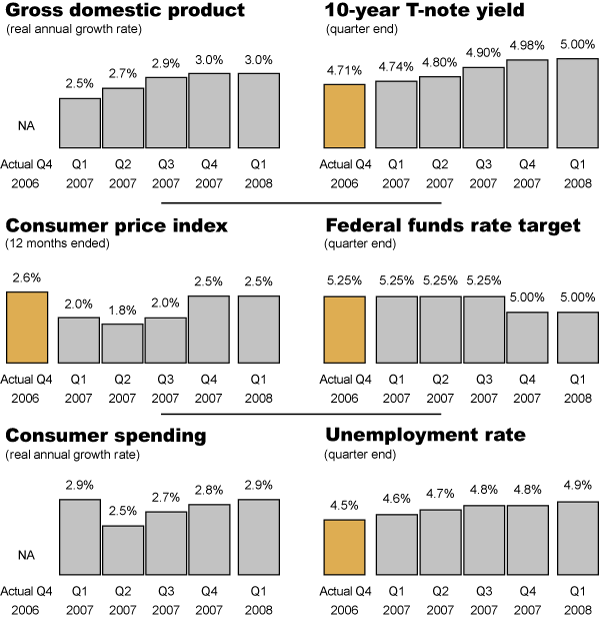|
January 31, 2007
Deficit Decline
Written by Jeff Thredgold, CSP, President, Thredgold Economic Associates
…despite all of the government spending of the past few years in Afghanistan and Iraq
…despite the excessive Republican-controlled pork barrel spending of the past few years (which helped lead to their Congressional leadership demise)
…and despite the fact that we now spend more than one billion dollars DAILY on just the interest on the national debt
…the budget deficit is likely to decline this year for the third consecutive time
Powerful growth in total tax revenue has helped to see recent annual budget deficits come in lower than prior expectations. The same result is likely in fiscal year 2007 (FY2007), which ends on September 30 of this year.
The FY2004 deficit was $413 billion (3.6% of GDP), the largest ever in dollar terms, but not close to deficits in the mid-80s and early-90s that reached as high as 5.0%-6.0% of GDP. The $413 billion deficit was followed by the $318 billion shortfall in FY2005 (2.6% of GDP), and the $248 billion deficit in FY2006 (1.9% of GDP).
A new projection from the non-partisan Congressional Budget Office for FY2007 sees a deficit of $172 billion, down sharply from the prior estimated deficit of $286 billion. The White House will also update (and lower) its projection in coming days. A FY2007 deficit below $200 billion…less than 1.3% of GDP…seems likely.
During the first three months of FY2007, overall tax collections ran 8.2% higher than during the same period in FY2006. This follows overall tax revenues jumping 12% in FY2006, which followed an even larger overall tax rise in FY2005.
The FY2006 rise was led by surging revenues in both corporate and individual tax receipts. Corporate tax receipts climbed 27% to $354 billion in FY2006, while individual income tax receipts jumped 13% to $1 trillion, largely fueled by rising tax receipts from wealthy taxpayers. Isn’t that what Democrats want?
Tax Cuts…Tax Revenue
Wait a minute! Didn’t we cut income tax rates across the board in recent years? Didn’t we cut tax rates on capital gains from 20% to 15%? Didn’t we cut the tax rate on dividends from as high as 35%-38% down to 15%?
…Doesn’t that mean that tax revenues will be lower? In the nation’s capital it does…in the real world it does not.
A Problem with Static
One problem when government cuts or increases tax rates is the fact that “static” analysis is used. This means that government computer models of projected tax revenue assume that people do not make any changes in their spending or investment decisions as far as tax changes are involved.
As a result, a lower tax rate “officially” projects that lower tax revenue will result. By the same token, a projected tax increase will lead tax revenue higher.
Most private sector forecasters have adopted “dynamic” analysis. Such models logically assume that American consumers and investors will modify their financial actions to take advantage of, or minimize the pain of, significant changes in tax rates.
Americans make rational decisions about money in most cases. The government has yet to figure that out.

Quarterly Economic Survey
|

|
The USA TODAY economic survey of 56 top economists was conducted January 18-24. Actual 4th quarter 2006 numbers (if available) and median forecasts through 1st quarter 2008:
|
|
USA TODAY • MONDAY, JANUARY 29, 2007
|
|
|
 |
Survey participants: Scott Anderson, Wells Fargo; Nariman Behravesh, Global Insight; Richard Berner, Morgan Stanley; David Berson, Fannie Mae; Kathleen Camilli, Camilli Economics; J. Dewey Daane, Vanderbilt University; Richard DeKaser, National City; Rajeev Dhawan, Georgia State University; Douglas Duncan, Mortgage Bankers Association of America; William Dunkelberg, National Federation of Independent Business; Mike Englund, Action Economics; Gail Fosler, The Conference Board; Lyle Gramley, Stanford Washington Research Group; Ethan Harris, Lehman Brothers; Maury Harris, UBS; Tucker Hart Adams, The Adams Group; Stuart Hoffman, PNC Financial Services Group; David Huether, National Association of Manufacturers; William Hummer, Wayne Hummer Investments; Saul Hymans, University of Michigan; Bruce Kasman, JPMorgan Chase; Paul Kasriel, Northern Trust; David Kelly, Putnam Investments; David Lereah, National Association of Realtors; Timothy Martin, Bank of America; Ken Mayland, ClearView Economics; Tim McGee, US Trust; Ed McKelvey, Goldman Sachs; Dan Meckstroth, Manufacturers Alliance/MAPI; Jim Meil, Eaton; Joel Naroff, Naroff Economic Advisors; Frank Nothaft, Freddie Mac; Joel Prakken, Macroeconomic Advisers; Maria Ramirez, Maria Fiorini Ramirez; Donald Ratajczak, Consulting economist for Morgan Keegan; Martin Regalia, U.S. Chamber of Commerce; David Resler, Nomura Securities; Timothy Rogers, Briefing.com; David Rosenberg, Merrill Lynch; Christopher Rupkey, The Bank of Tokyo-Mitsubishi UFJ; John Ryding, Bear, Stearns; Markus Schomer, AIG Global Investment Group; David Seiders, National Association of Home Builders; Robert Shrouds, DuPont; Allen Sinai, Decision Economics; James Smith, Parsec Financial Management; Sean Snaith, University of Central Florida; Sung Won Sohn, Hanmi Bank; Diane Swonk, Mesirow Financial; Gary Thayer, A.G. Edwards & Sons; Jeff Thredgold, Thredgold Economic Associates; Mark Vitner, Wachovia; Brian Wesbury, First Trust Advisors; David Wyss, Standard & Poor’s; Rich Yamarone, Argus Research; Mark Zandi, Moody’s Economy.com

“Tea”ser
Youth would be an ideal state if it came a little later in life.
|

